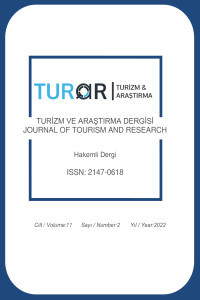Turistlerin Turizme Yönelik İnternet Kullanım Alışkanlıkları Üzerine Bir Araştırma
İnternet kullanımının yaygınlaşması pek çok sektöre olduğu gibi turizm sektörüne de bir takım yenilikler ve değişimler getirmiştir. Bu çalışmada Alanya destinasyonuna gelen turistlerin turizme yönelik internet kullanım alışkanlıklarını belirlemek amaçlanmıştır. Antalya ili Alanya ilçesinde yapılan bu araştırma için birincil verilerin toplanmasında anket tekniğinden yararlanılmıştır. Örneklemede tesadüfî olmayan örnekleme yöntemlerinden kolayda örnekleme yöntemiyle farklı otellerde kalan 686 turistle görüşülmüştür. Bu çalışmada ki kare analizi, faktör analizi, varyans analizi ve t testi yapılmıştır. Elde edilen bulgulara göre turistler otel ve acente seçim aşamasında öncelikle otelin ya da acentanın web sitesinden daha sonra ise Google vb. arama motorlarından bilgi almayı tercih etmektedir
Anahtar Kelimeler:
İnternet, E-turizm, Web Siteleri, Otel ve Acente, Turist, Alanya
A RESEARCH ON INTERNET USING HABITS OF TOURISTS ABOUT TOURISM
To pervade of internet usage has lead some changes and novelties in tourism sector as well as many others. The aim of this study is to determine tourists’ habits of tourism related internet usage that visit Alanya. The research was contucted in Alanya region. In the scope of this study, questionnaire survey which is a primary data collection method, is used. Convenience sampling method which is a type of non-random sampling method is used and in total 686 tourists were participated to the survey. In this study, chi-square analysis, factor
___
- Amadeus, (2013), “ Blog News From Amadeus”, http://www.amadeus.com, (02.04.2013).
- Berger, H., Dittenbach, M., Merkl, D., Bogdanovych, A., Simoff, S. ve Sierra, C., (2007),
- “Opening New Dimensions for E- Tourism”, Virtual Reality, 11, 75- 87. Buhalis, D. (1998), “Strategic use of Information Technologies in the Tourism Industry”,
- Tourism Management, 19:5, 1-22. Buhalis, D. ve Licata, M. C., (2002), “The Future e-Tourism Intermediaries”. Tourism Management, 23, 207–220.
- Buhalis, D. ve Law, R., (2008), “Progress in Information Technology And Tourism
- Management: 20 Years On And 10 Years After The Internet—The State Of Etourism Research”, Tourism Management, 29, 609– 623. Buhalis, D. ve Jun, S. H. (2011). E- Tourism, Contemporary Tourism Reviews Goodfellow Publishers, Oxford.
- Castaneda, J. A., Frias, D. M. ve Rodriguez, M. A. (2007), “The Influence of the Internet on
- Destinastion Satisfaction”, Internet Research, 17:4, 402-420. Çolakoğlu, O. E. ve Ataman, C., (2007), “İnternetten Pazarlama: İzmir İli Seyahat Acente
- Yöneticilerinin Bakış Açısı”. Seyahat ve Turizm Araştırmaları Dergisi, 172. Çubukcu, M. İ., (2010), “ Konaklama İşletmeleri Web Site İçeriklerinin Değerlendirilmesi”.
- İnternet Uygulamaları ve Yönetim Dergisi, 1, 39-59. Econsultancy. (2012). Internet Statistics Compendium. Econsultancty.com Ltd. Londra. Ekici,
- K. M. ve Yıldırım, A., (2010). E-Ticaret. Savaş Yayınevi, Ankara.
- Kamaruzaman, K. ve Handrich, Y. (2010), “E-Commerce Adoption in Malaysia: Trends,
- Issues and Opportunities”, ICT Strategic Review 2010/11 – E-Commerce for Global Reach, – 134.
- Luque-Martinez, T., Castaneda-Garcia, J. A., Frias-Jamilena, D. M., Munoz-Levia, F. ve Rodriguez-Molina, M. A. (2007). “Determinants of the Use of the Internet as a Tourist Information Source”, The Service Industries Journal, 27:7, 881-891.
- Mattila, A. S., (2004), “Consumer Behavior Research In Hospitality and Tourism Journals”
- International Journal of Hospitality Management, 23, 449-457. Mowery, D. ve Simcoe, T. (2002), “Is the Internet a US invention? An Economic and Technological History of Computer Networking” , Research Policy, 31: 1369–1387.
- Munar, A. M., (2011), “Tourist-Created Content: Rethinking Destination Branding”,
- International Journal of Culture Tourism and Hospitaliy Research, 5(3), 291-305. Nakip, M. (2006). Pazarlama Araştırmaları: Teknikler ve (SPSS Destekli) Uygulamalar.
- Seçkin Yayıncılık, Ankara. Peterson, R. A., Balasubramanıan, S. ve Bronnenberg, B.J., (1997), “ Exploring the Implications of the Internet for Customer Marketing”, Journal of the Academy of Marketing Science, 25 (4), 324-346.
- Pingdom, (2013). “ Internet 2012 in Numbers”. http://royal.pingdom.com/2013/01/16/internet-2012-in-numbers/ (E.T.: 02.04.2013).
- Sarı, Y. ve Kozak, M., (2005), “Turizm İşletmelerinde Doğrudan Pazarlama Çabaları
- Kapsamında Bilgi Teknolojilerinin Kullanımı”, İktisadi ve İdari Bilimler Dergisi, 19(1), 359- Sebastia, L., Garcia, I., Onaindia, E. ve Guzman, C., (2009), “E- Tourism: A Tourist
- Rcommendation and Planning Application”, International Journal of Artificial Intelligence Tools, 18 (5), 717- 738. Stockdale, R., (2006), “Managing Customer Relationships in the Self- Service Environment of E- Tourism”, Journal of Vacation Marketing, 13(3), 205-219. http://www.turizmaktuel.com/haber-16901-Ingiliz_tatilcinin_aliskanliklari_degisiyor_ E.T.: 12.2012
- ISSN: 2147-0618
- Yayın Aralığı: Yılda 2 Sayı
- Başlangıç: 2012
- Yayıncı: Toleyis Sendikası
Sayıdaki Diğer Makaleler
THE EFFECTS OF BELIEFS ON GASTRONOMY
Spor Pazarlaması Açısından Futbol Kulüplerine Taraftar Olma Nedenleri
Turistlerin Turizme Yönelik İnternet Kullanım Alışkanlıkları Üzerine Bir Araştırma
Mustafa GÜLMEZ, Saadet Zafer KAVACIK, Yaşar Yiğit KAÇMAZ, Paşa Mustafa ÖZYURT
Taşınmaz Kültür Varlıklarının Kültür Turizmi Açısından Önemi: Topkapı Sarayı Müzesi Örneği
